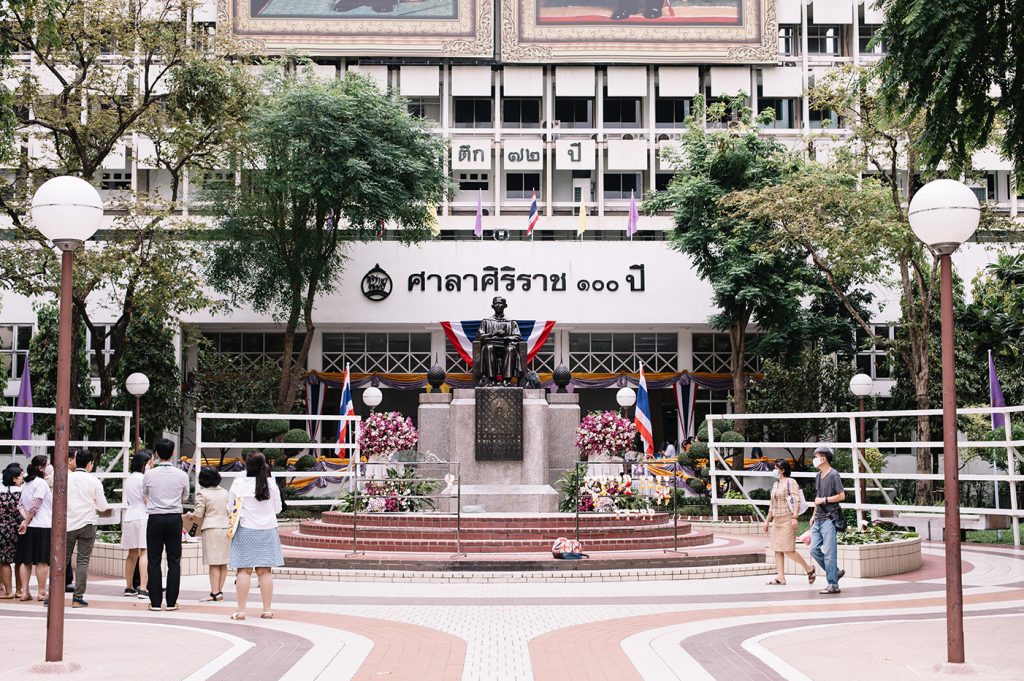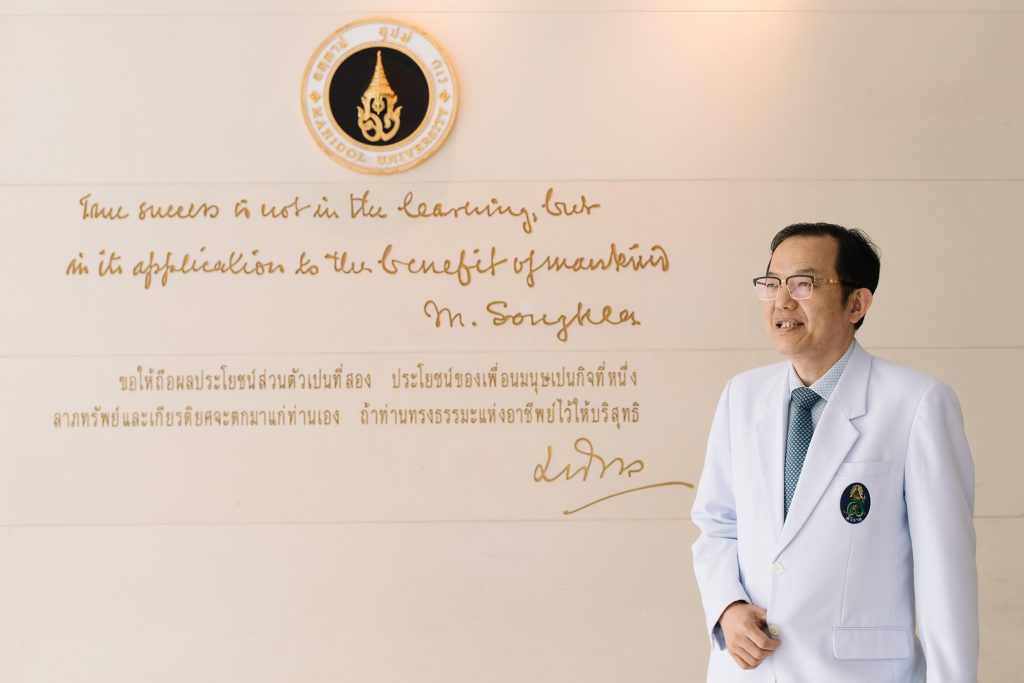Thailand will become a “full-fledged aged society” in the next 10 years, with one fourth of Thais being older than 60 years. Such demographic trend has significant impacts on public-health services in the regard to the number of patients and the frequency of medical visits. It is going to be more difficult to produce more health professionals to maintain the balance between the demand and supply in the public-healthcare sector by then. Without the balance, Thais’ needs for healthcare services may not be fulfilled with solid quality in the future.

To prevent the unwanted situation from happening, Smart Hospital concept has emerged. Many medical facilities have now embraced digital technologies in their bid to increase the efficiency of services and cost management. While these providers of healthcare services seek to better control the cost that has kept rising, they make significant efforts to uphold safety and quality.
“Siriraj Hospital”, one of Southeast Asia’s biggest medical facilities, has over 2,000 beds to accommodate inpatients. Each year, it has treated more than 3.8 million services. Siriraj Hospital’s deputy director Assoc. Prof. Cherdchai Nopmaneejumruslers tells dtac blog that his hospital’s five-year strategy (2020 – 2024) has a key goal of transforming Siriraj into a Smart Hospital. The transformation will be done under “Healthcare Everywhere” concept so as to ensure that the hospital can deliver services to any corner. Some patients will not have to travel to the hospitals to receive services such as preliminary screenings and symptom assessments anymore. In other words, the Siriraj Hospital intends to deliver Telehealth that has been a growing trend across the world.

“COVID-19 outbreak has accelerated our transformation into a Smart Hospital because more than 80 per cent of our patients need continuing care. In the face of COVID-19, social distancing is a must. So, to receive the much-needed continuing care, patients have turned to Siriraj Connect application,” the hospital’s deputy director explains.
Siriraj Connect, a Key to Smart Hospital
Launched in April 2019, Siriraj Connect is “an interface” whereby service users and can meet service provider. With this app, patients can get most types of Siriraj Hospital’s services.
In its first phase, Siriraj Connect’s goal is to let patients register themselves for services, check their queue, get the service, make payments and get medicines mailed to their place without the need to leave their home. Thanks to the app, patients will not have to spend unnecessarily long time at the hospital. They can also check their right to medical care in the comfort of their home be they members of the universal coverage healthcare scheme or social security scheme. At present, Siriraj Connect covers 13 clinics. Together, they have the capacities to take care of about 80 per cent of the hospital’s patients.

Siriraj Connect, so far, is still limited to “patients with chronic diseases”. To ensure safety, it is necessary that patients have received several medical visits before and telehealth services are given only as medial follow-ups. Siriraj Connect enables its users to consult medical specialists who may prescribe the same medicines or adjust medicines a bit.
According to Assoc. Prof. Dr. Cherdchai, Siriraj Connect has in fact attracted some service users prior to COVID-19 outbreak. While many patients stick to the traditional and familiar way of receiving healthcare services, those who know to how to leverage tech solutions appreciate Siriraj Connect because it allows them to manage several things themselves. Before COVID-19 outbreak, the app has got 30,000 downloads. After the outbreak, the number of downloads has doubled to 60,000. The increase marks a good sign for the Siriraj Hospital’s intention to transform itself into a Smart Hospital. Now, the Siriraj Hospital aims to get 300,000 downloads in its bid to serve half of its patients via telehealth.

“For each medical visit, patients have in fact shouldered much hidden costs such as travel expenses, accommodation cost, and the cost of time. So, it should be clear that Siriraj Connect benefits service users. The transformation into a smart hospital will enable us to manage resources with greater efficiency. We can reduce cost especially for items that do not add value such as waiting and parking areas,” Assoc. Prof. Dr. Cherdchai says.
“Voice” of Transitional Technology
While COVID-19 outbreak is undeniably a “catalyst” in the Siriraj Hospital’s transformation into a Smart Hospital, many patients have difficulties accessing telehealth services. Most patients in this group are the elderly, which account for 65 per cent of those needing continuing care. Recognizing this fact, dtac’s Call Center has stepped in to connect the elderly to the Siriraj Hospital’s telehealth.
Kanokphan Pattanasereechai, Head of Advisory Outbound, Customer Service at dtac, says, “I was interested in joining this project as soon as I heard about it. I considered it a good opportunity to serve the society and serve others. Many of our Call Center’s members have volunteered their services, even though it means losing some commission opportunities. They have jumped in with true public-mindedness”.
This mission, however, has its unique challenge. Communicating with the elderly who are not familiar with technologies can be very challenging. The team from dtac’s Call Center has dealt with this challenge well. Boasting expertise in call handling, the team has scored some successes. During the first six months of the mission, 40 per cent of elderly patients who have called the team or about 4,000 elderly patients have successfully downloaded Siriraj Connect.
“Voice reflects emotions of speakers. Though invisible to the eyes, voice can be felt. So, staff who have joined the mission must have very good attitudes, and be very patient as well as service-minded. They must treat callers the way they treat their grandparents. Another crucial tip is that we have installed a mirror at every desk of our Call Center so that our staff can look at their face while they are speaking,” Kanokphan says.

In support of this mission, dtac has used interactive voice response (IVR) as a default. Thanachai Chuklin, Head of Process Optimization, Customer Service at dtac, has designed IVR as a self service based on the concept of simplicity. With IVR, the workload of dtac team has eased significantly.
“IVR has connected patients to the hospital. It is the transitional technology between the Old World and the New World. It is here to help elderly patients access new-style services. No one will be left behind,” Thanachai explains.
“Data” as Telehealth’s Key Factor
Siriraj Connect marks a good start for the Siriraj Hospital’s transformation and Thailand’s shift towards telehealth. Technically, the app has already been well designed to give greater convenience to its users. For example, authentication via Know Your Customer steps (KYC) can be easily done via the app. There is no need for patients to contact the Medical Record unit. Next year, Siriraj Connect will expand to cover 90 per cent of the Siriraj Hospital’s services. Presently, the Siriraj Hospital aims to reduce patients’ time at its facilities from four hours to just one hour on average within the next two years. In the future, the hospital may take telehealth even further by making its services available to first-time service users with symptoms of non-communicable diseases.
Telehealth has its constraints, it should be noted, in events that the results of blood tests and x-ray are crucial to diagnoses. To give greater convenience to patients, they may be allowed to get a blood test or an x-ray from a hospital nearest to their home and submit results for Siriraj Hospital’s doctors to review in the future. Telehealth, in essence, will materialize only when “data” crucial to diagnoses and decision making are reliable and available. If doctors doubt data given, they may require patients to come to the Siriraj Hospital in person.

“Whether telehealth will win public acceptance depends on two factors – accuracy and safety. In the future, IoT (Internet of Things) devices will uphold these two factors in a much more efficient manner. With a wristwatch that can read blood pressure level, monitor blood oxygen level, and listen to the voice of lungs, doctors will have more data for their diagnoses,” Assoc. Prof. Dr. Cherdchai says.
The development of disruptive technologies plays a role in healthcare services based on “P4 Medicine”:
- Predictive: With data from IoT devices and interviews, it is going to be possible to predict health problems with greater accuracy.
- Preventive: Virtual clinic will be available round the clock for preventive medicine.
- Personalized: Healthcare services will be catered to the needs of each person.
- Participatory: Patients will have greater participation in healthcare.
When public healthcare becomes tech-driven, Healthcare Everywhere will materialize and upgrade people’s quality of life.

